SPARS during World War II
.
| In the beginning, the Navy, Marine Corps and
Coast Guard pooled their available facilities and staff to train women
together. Thus, Coast Guard reserve women were recruited by the Office
of Naval Officer Procurement and trained in naval schools already instructing
new WAVES.
By July 1943, the SPARS had their own recruiters
working in all District Coast Guard Offices.
Right: Early SPARS Recruitment
Poster asking for application at the nearest office of Naval Officer
Procurement. |
.v |
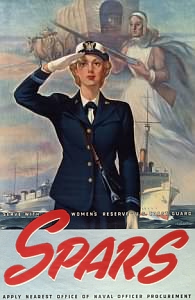 |
.
The actual recruiting campaign for SPARS began
in December 1942, and the first members (15 WAVES officers and 153 enlisted
WAVES) were selected directly from the Navy and transferred into
the Coast Guard. Many of the initial SPAR officers were assigned to Naval
Officer Procurement centers, where they coordinated recruiting and public
relations drives.
.
| Unlike the other armed forces, however, the
Coast Guard wanted a particular type of woman. The ideal recruit had to
possess outstanding athletic fitness, especially with regard to swimming
capability, have solid nautical knowledge (with sailing or yachting experience
preferred), and share the abolitionist Northeast tradition that appealed
to the New England-centered, maritime-rich Coast Guard tradition. However,
in keeping with American spirit, the upward pathway for social advancement
was based on merit for any women with maritime traits, even the daughters
of ordinary fishermen. |
.. |
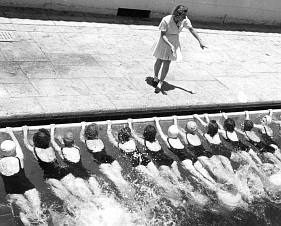 Swimming Training of SPARS
Swimming Training of SPARS
|
.
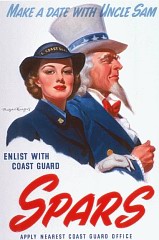 |
v |
It was not easy to find women steeped in maritime
heritage, correct philosophy toward open racial acceptance, and practical
expertise in sea lore.
Recruiters were also hampered by:
(a) the high wages paid by war
industries to women workers;
(b) the recruiting limitations
of the War Manpower Commission and Office of War Information, which disallowed
enlistment of critically needed women,
(c) parental and boyfriend objections,
(d) the hesitation of independent-minded
women to accept military lifestyles,
(e) the fear of being sent to
distant assignments in unknown areas
(f) the attitude of many women
- especially in the most-desired yachting and sailboat social circles --
that wartime sacrifice was not worth their personal time or effort, especially
if their social activities were curtailed. |
.
| The Coast Guard under Dorothy Stratton rose
to the challenge of gaining these desired women. It even opened its Coast
Guard Training Station for enlisted SPARS at a ritzy Palm Beach hotel,
so that recruiting promises could include basic training under glamorous
Florida seaside conditions. Captain Stratton was thus able to achieve her
goal of enlisting and appointing the exact type of athletic and nautical-savvy
Coast Guard women most sought after. |
.. |
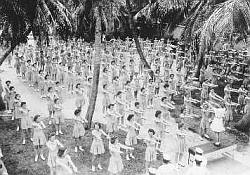 Morning calisthenics of
SPARS at the training center in Palm Beach
Morning calisthenics of
SPARS at the training center in Palm Beach
|
.
Commencing on 1 July 1943, in view of jealous
Navy competition for the "best girls," the Coast Guard separated its facilities
and strictly recruited and trained its own women. The Coast Guard reserve
recruits were medically examined by another Coast Guard gem of elite female
companionship -- the nurses and female doctors of the commissioned corps
of the Public Health Service. Under Captain Stratton, the Coast Guard reservoir
of ideally capable womanpower was enthusiastically filled.
.
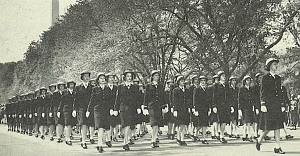 |
.v |
SPARS contingent in dress uniforms
march behind their officers and petty officers through Washington, DC,
during World War II.
All are expert swimmers and accomplished
nautical experts. |
.
| SPARS women mainly replaced men
in shore stations working in traditional clerical
and routine services. As the war progressed,
Coast Guard women were placed in charge of greater areas of previously
male-only control.
For example, a small group of SPARS worked
in the field of Coast Guard aviation as parachute riggers, link trainer
operators, aviation machinists' mates and air control tower operators.
Others worked as radio technicians, gunners' mates or radarmen. |
..v |
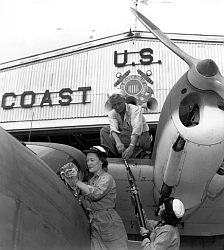 Aircraft maintenance by
SPARS
Aircraft maintenance by
SPARS
|
.
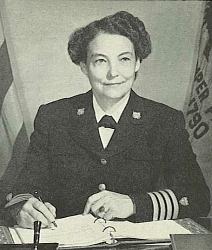 Captain Dorothy C. Stratton
Captain Dorothy C. Stratton
|
..v |
In December 1943, some of the limitations
on rank for women of the Coast Guard Reserve were removed by Congress to
enable greater contributions by SPARS in the war effort.
Lieutenant Commander Stratton was promoted
to Captain, which became the highest rank authorized for a SPAR officer.
Captain Stratton remained Director of the SPARS until September 1945. The
second Director of the SPARS became Captain Helen Schleman. |
.
| The first SPARS were assigned to overseas
duties in Hawaii and Alaska in September 1944 because of a basic Reserve
Act amendment that removed restrictions where SPARS could serve.
Both were important duty stations and many
SPARS eventually served in both places. |
.v |
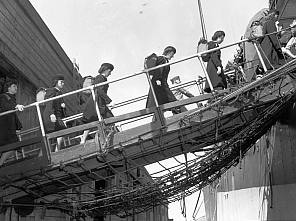 SPARS leaving for Hawaii
SPARS leaving for Hawaii
|
.
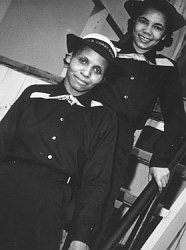 Olivia Hooker and Aileen Anita
Cooks on the ladder of the dry-land ship USS Nerversail during their
"boot" training
Olivia Hooker and Aileen Anita
Cooks on the ladder of the dry-land ship USS Nerversail during their
"boot" training
|
.v |
In October 1944, Afro-American women were allowed to enlist as SPARS,
provided they were fully qualified. Since the officer training program
for recruited civilians had already stopped, Black women were barred from
becoming officers directly from civilian life (the previous officer source
of many white women).
Four Black women were accepted into the SPARS during the first six
months that enlistment was opened to them. Although the officer training
was closed for any female civilians, it was possible to apply as officer
candidate and attend officer training for prior-enlisted SPARS (including
black enlisted SPARS). A few black women enlistees were commissioned as
ensigns before the end of the war. |
.
| Most members of the SPARS were very young
women. According to a survey from May 1943, the average age of enlisted
SPARS was between twenty-two and twenty-three. More than half of the enlisted
personnel were under 25 years old and nearly 90 percent under thirty. More
than 66 percent had graduated from high school and most of them had worked
for more than three years in a clerical or sales job. A large number of
women came from Massachusetts, New York, Pennsylvania, Illinois, Ohio or
California. |
.v |
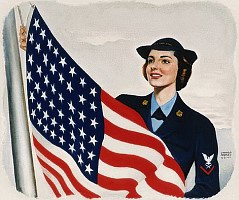 |
.
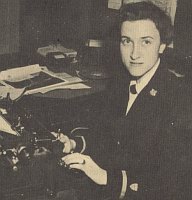
Ensign Mary C. Lyne, USCGR (W)
employed in the Office of Naval
Procurement in Washington, D.C. |
.v |
A similar survey from July 1943, regarding
SPARS officers, showed that the average SPAR officer was about 29 years
old. Only 10 percent of the SPARS officers were over forty.
Nearly all had graduated from college, a third
had even done some graduate work and 20 percent had earned master's degrees.
Most of them had worked for about seven years in either a professional
or a managerial position in the field of education or government. |
.
SPARS women contributed greatly to Coast Guard
management of all shore-based phases of the war effort. They conducted
various Coast Guard tasks in support of military readiness, assistance,
marine safety and law enforcement.
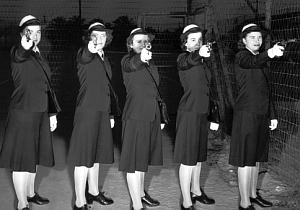 SPARS training marksmanship
... just in case
SPARS training marksmanship
... just in case
|
.v |
Their successful performance of vital administrative
and organizational functions extended their duty from purely clerical and
administrative tasks, as first envisioned, to the most important port security,
logistical and administrative jobs by war's end.
Known as the "women behind the men behind the
guns," female participation insured Coast Guard proficiency across the
Seven Seas during World War II. |
.
.
[ I. Development ]..[
II. Facts about the SPARS ]..[
III. Uniforms ]..[
IV. Sources ]
|
